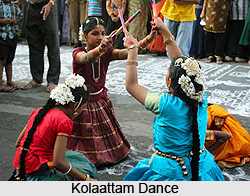 Kolaattam dance is an ancient village folk art performed in the Tamil Nadu state of India. It is also called as Kolannalu or Kolkolannalu. This dance form is famous in all parts of Tamil Nadu. Kolaattam is performed only by women. This folk dance is an amalgamation of rhythmic movements, songs and music. This dance form is performed during local village festivals. It offers a great variety of entertainment not only to spectators but also to the participants. Kolaattam is also performed in other states but is known by different names in different states of India.
Kolaattam dance is an ancient village folk art performed in the Tamil Nadu state of India. It is also called as Kolannalu or Kolkolannalu. This dance form is famous in all parts of Tamil Nadu. Kolaattam is performed only by women. This folk dance is an amalgamation of rhythmic movements, songs and music. This dance form is performed during local village festivals. It offers a great variety of entertainment not only to spectators but also to the participants. Kolaattam is also performed in other states but is known by different names in different states of India.
Etymology of Kolaattam
`Kol` means a small stick, and `Attam` means play, hence, a play or dance performed with sticks can be its simplest meaning. This is mentioned in Kanchipuram as `Cheivaikiyar Kolattam`, which proves its antiquity.
Performance of Kolaattam Dance
The group comprises of dancers in the range of 8 to 40. The dancers hold two sticks in each hand and beat those together to bring a rhythmic background. Owing to the usage of sticks, this dance is also called as "stick dance". Pinnal Kolaattam is also a form of this dance where ropes are used instead of sticks. One end of these ropes is held in the woman`s hand while the other is tied to a tall pole. Later, with planned steps, the women skip over each other, forming intricate lace-like patterns in the ropes. Then again, they unweave the lace by reversing the dance steps. This dance is very attractive for the eyes, as various colourful ropes are used. This dance is performed for ten days, starting with the Amavasi or New-moon night after Deepavali.
Costume of Kolaattam Dance
The costume of this dance is mainly traditional. They wear ornaments to complete their look which mainly comprise of necklace, bangle and ear ring. They also tie their hair in a bun or plait and adorn it with decorative flowers and ornaments.
Festival Connected with Kolaattam
The festival connected with Kolaattam has both a cultural and a religious significance. A legend is responsible for celebrating this festival after which, this festival is celebrated as Kolatta Jothrai in a number of places in Tamil Nadu.



















